Casket
Unknown Flemish, 15th century
Below the image, click play to listen.
Oak
Flemish, 16th century
Churches and cathedrals throughout time have something architecturally in common: a location for the choir. Where the choir is placed differs in the various places of worship, yet the choir accentuates the central focus of the church: the altar. In many early European monasteries and later collegiate churches, the choir was positioned along the chancel which separates the nave (where the laity would sit) from the altar. The chancel is lined with rows of seating for the choir members. Every detail within Medieval and Renaissance places of worship were handcrafted, including the choir’s seating or choir stalls.
Choir stalls consist of carved, individual seats divided by armrests; these seats are attached to a long, carved dorsal panel (a short or high backrest board) and sometimes a canopy. M&G’s pair of sturdy oak Choir Stalls date to the 16th century and were designed by Gothic Flemish artist Jan Terwen Aertsz.
Little is known about Jan Terwen Aertzs. who lived a long life of 78 years. Born in 1511 and later educated at the Dordrecht School, Jan was considered a master woodcarver in Dort, also known as Dordrecht. While the exact church in the Netherlands from which M&G’s Choir Stalls originate remains a mystery, the location of Jan’s greatest work is on view in the Grote Kerk in Dordrecht. The church’s choir stalls, made between 1538-1542, demonstrate Jan’s skill and eye for detail, and are pristine examples of Flemish woodworking in the 16th century.
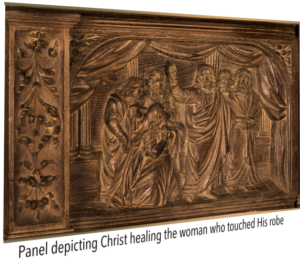 M&G’s Choir Stalls provide two sets of four seats each and are covered in finely detailed carvings. For example, the fins under the armrest are devised to look like eagles with every feather individually carved into the hard oak. The dorsal and end panels of the stalls contain images from various Biblical stories, including King Solomon displaying his God-given wisdom with the two mothers, and the believing woman healed by just a touch of Christ’s robe. Every minute design is accounted for—from the patterned hem of a character’s tunic, and the hair on Jesus’ head and beard, to the scenes’ distant mountains in the background, and the patterns in the tile underfoot. Surrounding these narratives are decorated spindles and more reliefs consisting of fruit and flowers flanked by winged, mythological creatures.
M&G’s Choir Stalls provide two sets of four seats each and are covered in finely detailed carvings. For example, the fins under the armrest are devised to look like eagles with every feather individually carved into the hard oak. The dorsal and end panels of the stalls contain images from various Biblical stories, including King Solomon displaying his God-given wisdom with the two mothers, and the believing woman healed by just a touch of Christ’s robe. Every minute design is accounted for—from the patterned hem of a character’s tunic, and the hair on Jesus’ head and beard, to the scenes’ distant mountains in the background, and the patterns in the tile underfoot. Surrounding these narratives are decorated spindles and more reliefs consisting of fruit and flowers flanked by winged, mythological creatures.
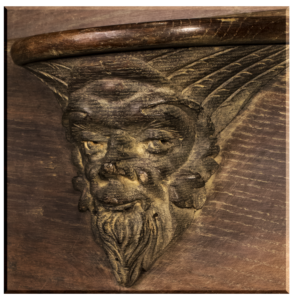 One of the most fascinating details of the Choir Stalls are the misericords. Misericords (from the Latin word for pity and heart, literally pity of the heart or compassion of the heart) are molded brackets on the underside of a seat. Choirs or monks would stand for hours singing and participating in the worship ceremony; to provide them with a modicum of comfort and stability, these misericords or “mercy seats” were added. When the choir members would stand to sing, they could lift the seat up and surreptitiously rest against this small structure while still appearing to be standing.
One of the most fascinating details of the Choir Stalls are the misericords. Misericords (from the Latin word for pity and heart, literally pity of the heart or compassion of the heart) are molded brackets on the underside of a seat. Choirs or monks would stand for hours singing and participating in the worship ceremony; to provide them with a modicum of comfort and stability, these misericords or “mercy seats” were added. When the choir members would stand to sing, they could lift the seat up and surreptitiously rest against this small structure while still appearing to be standing.
The ownership history, or provenance, of these beautiful seats is long, mysterious, and fascinating. The choir stalls survived the iconoclasm that followed the Protestant Reformation sweeping through the Netherlands as staunch Catholic Philip II of Spain fought to retain Flanders, where they remained undamaged until the early 20th century. As America entered the Gilded Age with its booming economy, many American business and factory owners became millionaires; they wished to display their newly-earned wealth and position by designing grand homes decorated in the Old-World style. Men like architect Stanford White were sent to Europe to purchase whole rooms of traditional Medieval or Renaissance décor and ship the furnishings back to America. White chose the Choir Stalls to adorn Hearst Castle built by William Randolph Hearst, the newspaper magnate. The choir stalls decorated Hearst’s home until his bankruptcy during the Great Depression. In 1941, Hammer Galleries acquired the choir stalls at auction. A later owner gifted the Choir Stalls to the Collection in 1968, where they found a home among objects and paintings of the same age. While they are not being used for their original purpose, the Choir Stalls allow M&G’s guests a glimpse into 16th-century cathedrals.
Ashley Ellis, M&G History Intern
Published in 2019
Polychromed and gilt wood
Although the title Watchers and Soldiers from a Crucifixion Group seems insipid at first read, these two small polychromed and giltwood sculptures provide fascinating insights into an architectural style and installation of extreme magnitude. During the reign of Ferdinand and Isabella, the Spanish monarchs who commissioned Columbus’ 1492 voyage to the Americas, the Isabelline style of architecture was developed. Born in France and trained in Flanders, Juan Guas settled in Toledo to establish his business. He is considered one of Spain’s finest architects and one of the key originators of the Isabelline style, which combines a Flemish-Gothic influence with Mudéjar (Spanish-Muslim) ornamentation. His design influence is represented in the monumental edifices at the San Juan de los Reyes and El Paular monasteries.
M&G’s two figural groups date to the second half of the 15th century and according to William Holmes Forsyth, the late curator emeritus of medieval art at the Metropolitan Museum of Art, “They are from a retable or retablo of Spanish origin, but southern Netherlandish in inspiration.” Beatrice Gilman Proske, the former research curator of sculpture at the Hispanic Society of New York who authored the catalog for the famed outdoor sculptures of Brookgreen Gardens, noted that they are Flemish. It is not then a stretch of scholarship to assume that these two sculptures measuring 32” high by approximately 15” wide, would have commanded a prominent place flanking the carved crucifixion of Christ, a common focal point in many retables from the Low Countries of the time. The Carved Retable of the Passion of Christ, part of the collection at the National Gallery of Victoria in Melbourne, Australia, presents a prime example.
At the base of each carving’s scene amidst the jagged rock are bones resembling those from the lower torso and limbs of the human body. These skeletal remains add a sobering reminder that Roman crucifixion included the breaking of the leg bones in order to hasten the impending death. Moreover, the crucifixion of Jesus, as noted by all three synoptic Gospels, occurred on Golgotha or “the place of the skull.”
Positioned on these rocky formations, the Soldiers are each individualized by gaze and weaponry and robed in medieval armor and Moorish headdress, hinting at the Mudéjar influence. The sculptor clearly draws our attention to the only soldier gesturing and glancing upward, perhaps depicting the centurion cited in the Gospels of Matthew, Mark and John. Church history, tradition, and pseudepigrapha all ascribe the name of Longinus to this legionnaire, but Scripture allows him to remain anonymous, recording for all time only his striking statements, “Truly this was the Son of God” (Matthew 27:54) and “Certainly this was a righteous man.” (Luke 23:47)
Unlike the soldiers, the Watchers from a Crucifixion Group can be decoded from Bible references, religious iconography, and an abundance of artistic renderings of those who attended Christ’s crucifixion. The repertoire is rich as set forth in examples such as El Greco’s Crucifixion, and Jan Van Eyck’s.
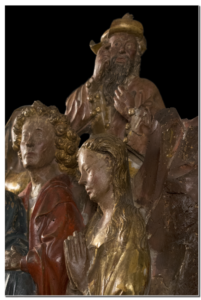 At center front Mary, the mother of Jesus, robed in blue (alluding to heaven, truth, and mourning) and white (for purity and innocence) is comforted by the obviously young apostle John draped in red (for love). On either side of him stand the two Marys, clearly identified in the crucifixion passage in John’s gospel as Mary the wife of Cleophas, and Mary Magdalene (recognized by her long hair as a penitent saint). In the background, towering above the rest of the group, is most likely Joseph of Arimathea, who provided the burial tomb for Christ; he is presented as elderly and robed in the costly garments of the rich. The sculptor carved this individual with an intriguing gesture. With his right index finger raised to his temple, perhaps Joseph is recalling the Scriptures he memorized while serving as a Sanhedrin senator attesting to the deity of Jesus, the Christ.
At center front Mary, the mother of Jesus, robed in blue (alluding to heaven, truth, and mourning) and white (for purity and innocence) is comforted by the obviously young apostle John draped in red (for love). On either side of him stand the two Marys, clearly identified in the crucifixion passage in John’s gospel as Mary the wife of Cleophas, and Mary Magdalene (recognized by her long hair as a penitent saint). In the background, towering above the rest of the group, is most likely Joseph of Arimathea, who provided the burial tomb for Christ; he is presented as elderly and robed in the costly garments of the rich. The sculptor carved this individual with an intriguing gesture. With his right index finger raised to his temple, perhaps Joseph is recalling the Scriptures he memorized while serving as a Sanhedrin senator attesting to the deity of Jesus, the Christ.
Bonnie Merkle, Docent and M&G Databases Manager
Published in 2019
M&G’s Founder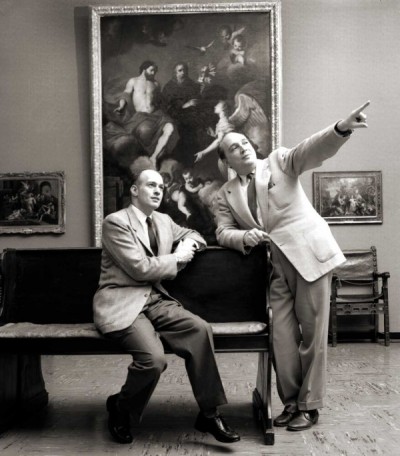
Robert Reynolds Jones Jr. was born in Montgomery, Alabama on October 19, 1911. In his long life, he achieved great distinction as an actor, scholar, preacher, university administrator, and art connoisseur. His interest in Shakespeare brought him national fame in his 20s through his lyceum presentation, Curtain Calls. Later, he founded the University’s theatre company, The Classic Players; the Bob Jones University Opera Association; a School of Cinema; and an Artist Series program. In addition, he became the second president of Bob Jones University and maintained an active preaching ministry.
In 1948, Carl Hamilton, a collector and friend, suggested that Dr. Bob channel his interest in the visual arts into collecting paintings for an art gallery. What began as less than thirty paintings in two rooms has become a world-famous collection of sacred art.
On November 12, 1997, after a brief battle with cancer, Dr. Bob Jones Jr. entered heaven. His ministry and legacy live in our memories, a world-renowned art collection, and the lives of people saved under his preaching.
Adapted from Standing Without Apology: The History of Bob Jones University by Daniel L. Turner, Fortress of Faith, by Melton Wright, and Fifty Years Under God by Margaret Beall Tice.
Oil on canvas
English, 1829-1891

Vashti showcases Edwin Long’s interest in archeological discovery, religious history, and female beauty on a grand scale, interests that reflect those of the Victorian era in which he lived. And the story of the two queens of Xerxes, king of Persia, is tailor made for both his interests and his skills. Like other religious painters of the era, such as William Holman Hunt, Long actually visited the Holy Land to gain firsthand knowledge. He combined this trip with various print sources such as volume III of George Rawlinson’s The Five Great Monarchies of the Ancient Eastern World (1862-67) and Austen Henry Layard’s studies from Nineveh in order to create this painting of convincing Orientalism. Originally exhibited at Burlington House in 1879 with its companion piece, Queen Esther, the two paintings taken together (though not exhibited side by side) offer food for thought both on the characters of these impressive women and the critical period in which they lived.
Vashti opens the story of Esther with a dramatic refusal to appear at her husband’s banquet for the rulers of the Persian kingdom. Whether she refuses out of modesty (her crossed arms seem to support this position) or because she herself is hosting a banquet for the wives of the rulers, her refusal is seen as a harbinger of marital unrest in the kingdom if her disobedience goes unanswered. So the king is persuaded to depose her as queen and seek a new one. There are several indications that Vashti recognizes the serious implications of her rebellion. She is remonstrated by her maidens, there is an apparent altercation at the door between those delivering her refusal and those demanding her acquiescence, and her body language suggests that she is afraid of what is to come.
The symbolism so greatly loved by the Victorians comes into play through the great lion on which she sits. An emblem associated by the Persians with their great power, the lion reflects both the power that has made her queen and the power which she will be unable to thwart. Though the lion is itself slain and has lost its power over her, even serving as a bench cushion; one lone woman cannot stand against an Eastern potentate. Her name which means “Beautiful One” in Persian appropriately reflects her physical beauty, likely the avenue to her queenly position. However, beauty is hardly a weapon against the mighty Persians. Or is it?
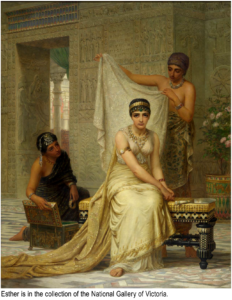 Consider the story of Hadassah or Esther as most know her today. An entire book of the Bible, one in which there is no direct mention of Jehovah, chronicles a few brief years of a young Jewish maiden who had “come to the kingdom” (Esther 4:14) at a crucial time, not just as a result of the whim of the queen. Long means for viewers to examine these women in light of each other. A cursory glance reveals that the two paintings are meant as companions: the matching frames, the seated central figures, the inquisitive gaze and pose of the servant girl, the visible sandaled foot of both women. Even the “X” created by the arms of Vashti and the jewelry of Esther juxtapose these two women and their plights: one is apparently guarding her beauty from the ravaging eyes of the rulers, the other finds her beautiful figure emphasized in the king’s competition.
Consider the story of Hadassah or Esther as most know her today. An entire book of the Bible, one in which there is no direct mention of Jehovah, chronicles a few brief years of a young Jewish maiden who had “come to the kingdom” (Esther 4:14) at a crucial time, not just as a result of the whim of the queen. Long means for viewers to examine these women in light of each other. A cursory glance reveals that the two paintings are meant as companions: the matching frames, the seated central figures, the inquisitive gaze and pose of the servant girl, the visible sandaled foot of both women. Even the “X” created by the arms of Vashti and the jewelry of Esther juxtapose these two women and their plights: one is apparently guarding her beauty from the ravaging eyes of the rulers, the other finds her beautiful figure emphasized in the king’s competition.
Both women are “caught” by their positions though their gazes differ: Vashti’s gaze foreshadows her fall from favor while the frank gaze of the powerless girl (even her beauty is no match for an unextended scepter) foreshadows her strength of spirit. The adorned Esther has put down the mirror, rejecting the offer of more jewels. Instead, just prior to being veiled and taken to Xerxes, she looks directly at the viewer. This gaze, though solemn, reveals no fear in the innocent young girl (notice the lilies on the wall relief behind her) who by the next day will be either a mere concubine or the queen. The mythical griffins embroidered on the hem of her gown were figures used to guard the gold of the Persians and are another indication both of the marketplace contest she is part of and her inability to escape. Yet Esther has an inner strength that enables her to risk death at the hands of the king—in order to invite him to dinner!
Though Vashti is gone by the end of the first chapter of Esther, she begins the rising action of the story whose crisis is faced by her youthful successor. Without the brave action of Vashti, Esther would not have been in place to rescue her people. And without the brave action—and clever thinking—of Queen Esther, the Israelites would have lost their stand against the “divine” power (note the stylized sun on the end of the mirror handle and on Vashti’s belt) of the pagan Persians at the hands of Haman. If “the king’s heart is in the hand of the Lord” (Proverbs 21:1), it is certain the hearts of queens are as well. Edwin Long’s works draw attention to both the historical tensions in the Persian royal court and the metanarrative of the Israelites’ position as God’s chosen people.
Dr. Karen Rowe, M&G Board Member
Published in 2019
Polychrome and giltwood walnut
Austrian, 1570-1630
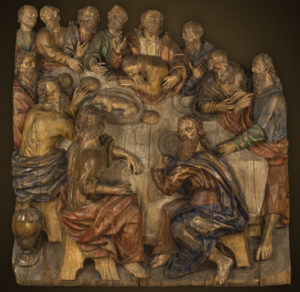
One of Scripture’s more commonly depicted stories in art is the Last Supper. This event is represented repeatedly in M&G’s own collection in at least three paintings (on both canvas and panel), a Greek icon, book engravings, Sitzendorf porcelain, and wood sculpture.
Created around 1625, M&G’s sculptural Last Supper is attributed to Hans Waldburger, an Austrian artist in both wood and stone. Little is recorded about him, but he learned his craft from his father, Hans Leonhard Waldburger, while growing up in Innsbruck, Austria. Hans was later guided by Alexander Colin and Hubert Gerhard, a northern follower of the influential Michelangelo-emulator, Giovanni Bologna (or Giambologna).
During Waldburger’s life and work, there was a cultural shift through the influence of both the Protestant Reformation and the Roman Catholic Counter Reformation. Artistically, that transition was expressed through the Mannerist style briefly bridging the movement of the simple, idealized forms of the Renaissance to the busy, dynamic embellishment of the Baroque. This developing ornamentation was articulated in a highly decorative, theatrical style often combining painted imagery with sculptural elements giving the illusion of the story emerging from the flat surface—almost coming to life.
Early in Hans’ career he was commissioned by Archbishop Wolf Dietrich von Raitenau to Salzburg, where he essentially spent the rest of his life. Much of his known work is represented in Austria including such fine examples as the High Altar at both the Basilica Mondsee and Salzburg Cathedral.
M&G acquired The Last Supper in 1963. It is roughly 400 years old and still retains much of its painted color (polychrome) and gold leaf (gilding) in places. Hans’ mannerist style is noticeable in the extended physical features of the apostles as they are seated around the table. The possible supper conversation may be the point in the story when Christ reveals that one of the twelve disciples would betray Him. Their response was, “Is it I?” as recorded in the gospels (Matthew 26:22; Mark 14:19). Though it is known in the culture of Palestine that the partakers would have reclined during the meal, here the group is seated around a table. The sculpture measures approximately 4 feet wide by 4 feet high, and it is almost 1 ½ feet thick! Remarkably, the figures’ distinctive details including curling beards, facial features, and gesturing hands are still intact.
Dealer Edward R. Lubin summarizes the beauty and impact of Waldburger’s Last Supper, “A monumental, virtually in-the-round sculptural group of such quality and scale in this period of German art is truly exceptional.”
John Good, Security Manager
Published in 2019